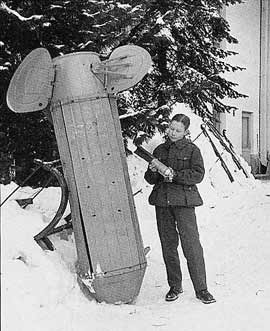The Explosive Aperitif

Many advances in science or technology are named after their inventors. This is often true in warfare; for example, the Gatling gun is named for its creator, Richard Gatling, and the term “shrapnel” is named for Henry Shrapnel, a British Major General who first developed the tech. But in one notable case, the weapon in question is named not for its creator, but as a joke — a tongue-in-cheek reference to a tormentor.
On August 23, 1939, on the cusp of World War II, the Soviet Union and Germany entered into a non-aggression pact. The agreement contained an undisclosed stipulation buried within it which divided up much of Eastern Europe among the pact’s two parties. Per the stipulation, the Soviet Union was to extend its “sphere of influence” (as the language of the era euphemistically employed) to the Baltic states and Finland. The Baltics, comprised of Estonia, Latvia, and Lithuania, capitulated to Soviet control rather easily, seeing no way to resist the military might of the USSR. Finland, on the other hand, took to arms. The USSR and Finland were engaged in what is now known as the Winter War, which began in November of 1939 and lasted until the Finns finally agreed to cede some territories in March of the following year.
One of the more innovative weapons used by the Soviets, especially early in the war, was a aerial bomb known as RRAB-3, pictured above. The RRAB-3 could be dropped from Soviet bombers flying about Finland, like any other conventional bomb of its era. But what made the RRAB-3 particularly destructive was what happened on its way down to the ground. At one point during its descent, the bomb’s nose would open, releasing dozens (if not more) of smaller bombs designed to start fires upon impact. The RRAB-3, therefore, could cause a lot of damage over a rather wide area, despite the lack of a major explosion.
But, at the time, if you asked the Soviet foreign minister about the bombs, he’d have denied that his nation were doing any such thing. The RRAB-3, he argued, was a humanitarian device. Finns were starving, he asserted, and the Soviets were dropping rations to the them. This was a lie, of course; the Finns were doing quite well, except for the invading Soviet tanks and falling Soviet bombs, and the bombs were bombs, not food. So the Finns gave the RRAB-3s a nickname, after the aforementioned Foreign Minister. That man was Vyacheslav Molotov, and the RRAB-3 earned the nickname “Molotov’s bread basket.”
The Finnish counter to the tanks, at least, was a concoction of flammable liquids such as gasoline, poured into breakable glass bottles and outfitted with kerosene-dipped rags as wicks. All of the materials, being household items, were common enough to make this weapon an accessible, popular tool against the invading Soviets. Finns called these fire bombs “Molotov cocktails” — “a drink to go with the food.”
Bonus Fact: In 2001, the United States began a military campaign against Afghanistan in response to the 9/11 attacks. One of the American’s priorities in Afghanistan was to limit the harm to civilians, so the U.S. dropped humanitarian aid — food rations — as well as cluster bombs. One problem, though? The food rations were yellow, which made them look a lot like unexploded cluster bombs.The U.S. military changed the color of the rations.
From the Archives: Saving Lives, Many Bullets at a Time: The strange history of the Gatling gun.
Related: A book on the Winter War. 4.4 stars on more than 80 reviews.
